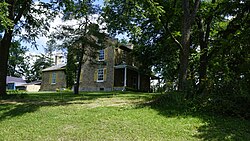Egmondville | |
|---|---|
Unincorporated rural community | |
 The Van Egmond Residence | |
| Coordinates: 43°32′41″N81°24′11″W / 43.54472°N 81.40306°W | |
| Country | Canada |
| Province | Ontario |
| County | Huron |
| Municipality | Huron East |
| Time zone | UTC-5 (Eastern (EST)) |
| • Summer (DST) | UTC-4 (EDT) |
| GNBC Code | FEHQG [1] |
Egmondville is an unincorporated rural community in Huron East, Huron County, Ontario, Canada. [1] [2]

